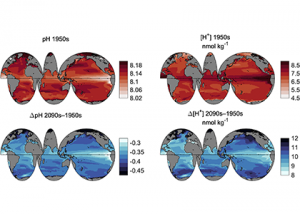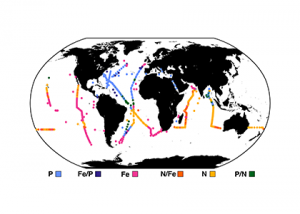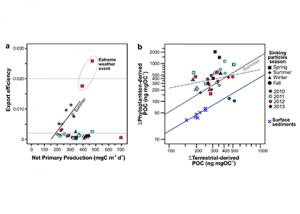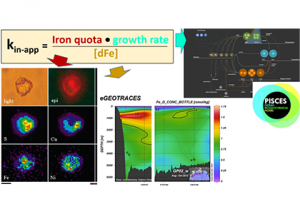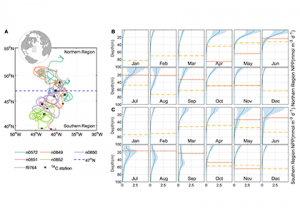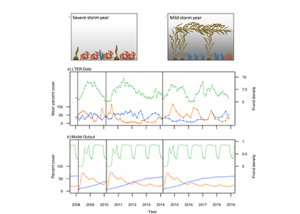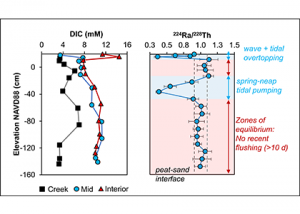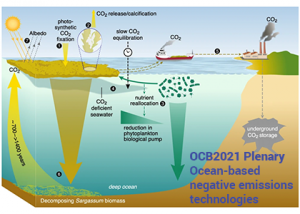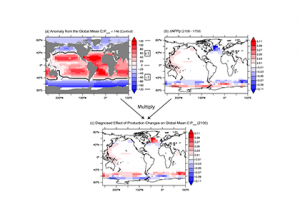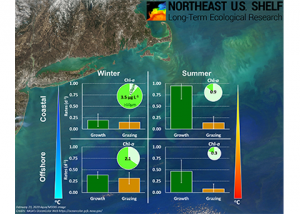If you would like to have your recent publications featured on the OCB website please contact ocb_news@whoi.edu. View our guidelines for writing a New OCB Research post.
The Intergovernmental Panel on Climate Change (IPCC) defines ocean acidification as “a reduction in pH of the ocean over an extended period, typically decades or longer, caused primarily by the uptake of carbon dioxide (CO2) from the atmosphere” (Rhein et al., 2013, p. 295). Does this mean that a greater change in pH at the ocean surface relative […]
Read MoreIn the surface ocean, phytoplankton growth is often limited by a scarcity of key nutrients such as nitrogen, phosphorus, and iron. While this is important, there are methodological and conceptual difficulties in characterizing these nutrient limitations. A recent paper published in Science Magazine leveraged a global metagenomic dataset from Bio-GO-SHIP to address these challenges. The […]
Read MoreSinking particles are a critical conduit for the export of material from the surface to the deep ocean. Despite their importance in oceanic carbon cycling, little is known about the composition and seasonal variability of sinking particles which reach abyssal depths. Oligotrophic waters cover ~75% of the ocean surface and contribute over 30% of the […]
Read MoreIn many oceanic regions, iron exerts strong control on phytoplankton growth, ecosystem structure and carbon cycling. Yet, iron bioavailability and uptake rates by phytoplankton in the ocean are poorly constrained. Recently, Shaked et al. (2020) (see GEOTRACES highlight), established a new approach for quantifying the availability of dissolved Fe (dFe) in natural seawater based on […]
Read MoreNet primary production (NPP)—the organic carbon produced by the phytoplankton minus the organic carbon respired by phytoplankton themselves—serves as a major energy source of the marine ecosystem. Traditional methods for measuring NPP rely on ship-based discrete sampling and bottle incubations (e.g., 14C incubation), which introduce potential artifacts and limit the spatial and temporal data coverage […]
Read MoreGiant kelp is a highly productive foundation species that forms dense forests on temperate reefs around the world. These ecosystems have remarkably high rates of carbon fixation—giant kelp can grow half a meter a day—and the physical structure formed by kelp’s tall fronds profoundly alters the benthic habitat. However, giant kelp is regularly ripped out […]
Read MoreTidal wetlands are highly productive ecosystems that have the potential to sequester and bury vast quantities of atmospheric carbon dioxide, making them effective blue carbon habitats. There is emerging evidence that lateral export of dissolved carbon (outwelling) can greatly exceed carbon burial in blue carbon habitats. However, little is known about the spatial and temporal […]
Read MoreThe world is in need of effective methods to reduce CO2 in the atmosphere, and the ocean could potentially help us to meet this objective. One idea, explored since the 1980s, is to grow seaweeds on platforms in the open ocean to fix carbon and sequester it at great depth (ocean afforestation). But would that […]
Read MoreThe C:N:P stoichiometry of global ocean biological production is the gear by which marine biology turns the wheels of the global ocean carbon cycle. From the days of Alfred Redfield until fairly recently, this stoichiometry was assumed a constant in ocean biogeochemistry (e.g., the Redfield ratio). Traditional stoichiometry would predict a carbon export production decline […]
Read MoreIt is critical to quantify the amount of phytoplankton that microzooplankton consume to better understand the flow of carbon toward higher trophic levels in the ocean. The Northeast US Shelf (NES) sustains intense fisheries with huge economical importance, but the links between the planktonic food web and the fish stocks are poorly constrained. A recent […]
Read More
